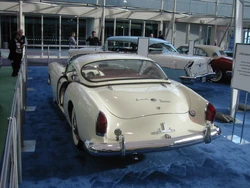A sliding door is a type of door that opens by sliding (usually horizontally), whereby the door is either mounted on or suspended from a track. These aren't usually used in small vehicles, but generally they're most commonly used for minibuses and buses to provide a large entrance or exit for passengers without obstructing the pavement. They are often used on the side of commercial vans as well, as this allows a large opening for equipment to be loaded and unloaded without obstructing access.[1]

A minibus with a sliding door
Sliding doors are often used in mini MPVs such as the Toyota Porte and Peugeot 1007 and Renault Kangoo, but are more commonly used in full-sized MPVs like the Toyota Previa, the Citroën C8, the Peugeot 807, the Chrysler Voyager and the Kia Sedona.[1][2] Their use has increased over the years as MPVs have increased in popularity, because it gives easy access and makes parking in tight spaces possible.[1] The most common type of sliding door, that has a three-point suspension and opens outwards, then runs along the side of the vehicle, was introduced in 1964 by Volkswagen AG as an option on its Type 2 vans.
Unconventional styles[]
Pocket doors[]

A Kaiser Darrin - visible in this picture are the pocket doors that slid forward into the fender.
A pocket door is a sliding door that slides along its length and disappears, when open, into a compartment in the adjacent wall, or as in terms of vehicles, into the car's bodywork. Pocket doors are often used in architecture, but rarely in vehicles.
1953 Kaiser Motors[]
Kaiser was the first and only car manufacturer to feature pocket doors, although not all of their cars had pocket doors.[3][4] To date, no other vehicle has utilised pocket doors. Their unique pocket doors slide tidily into the front fender, which leaves the vehicle looking a lot more aesthetically pleasing than the doors sliding outside of the bodywork.
Vertical doors[]
A vertical door is a type of sliding door that slides vertically, usually on a rail or track.
1989-1991 BMW Z1[]

A BMW Z1 with its doors open
The BMW Z1's unusual vertical-sliding doors are one of its most interesting features. The doors slide-vertically down into the car's chassis. This means that they slide into a compartment within the car's body and so are also technically pocket doors, but they aren't classified as such because they don't slide along their length into an adjacent compartment. The inspiration for these doors came from traditional roadsters which often feature removable metal or cloth doors. Because removable doors did not fit within BMW's design goals, the vertical-sliding doors were installed instead.
Because the doors slide vertically downwards into the body, the top halves of the sides of the car slide into the bottom half. The high sills can make entry and exit harder, although they do offer crash protection independent of the doors, so the vehicle may be legally and safely driven with the doors up or down. BMW never imported the Z1 to the U.S. They are legal in the U.S., but only when the car is imported under the NHTSA's Show & Display exemption for technologically and historically significant vehicles.
The windows can be operated independently of the doors, although they will automatically retract if the door is lowered. [10]
1993 Lincoln Mark VIII concept car[]
The Lincoln Mark VIII concept car's doors slide into the frame underbody and disappear from view.[5] By doing this, it eradicated the problem of a high door sill that the Z1 experienced. However, this design is much more complicated, so the risk of failure is increased. Also, all of the mechanisms to make the doors work add a significant amount of weight to the car, slowing it down, and making it less efficient.
This was designed because Lincoln executives were concerned about the large heavy doors on the Mark VIII and wanted to improve them, especially for cities with tight parking spaces. They had the idea of a Mark VIII that had doors that disappeared beneath the car and would require no additional space outside the car's wheelbase for the doors to open in order to allow people to enter or exit. At this time it was usual for the large car manufacturers to sub-contract their concepts to other companies who specialized in making concepts reality. In this case, this Mark VIII was sent to Joalto Design Inc. near Detroit. Joalto still holds many US Patents for with this vehicle's chassis and body construction.[6][7][8][9][10]
Joalto Design Inc. created this one-of-a-kind concept car and shipped it back to Lincoln for executive approval for production. Unfortunately, the executives didn't like the design and ordered for the car (and the concept) to be sent to the scrapheap and destroyed. Fortunately the car wasn't destroyed, and was sold on Ebay in September 2007.[6]
Inner-Track sliding door[]
Opens normally like a traditional van sliding door, but unlike most sliding doors where the track is on the exterior of the vehicle, this type has it inside and on the side of the door itself. This allows the exterior to remain clean in design and yet the door can slide past the trailing edge of the car. However, this design is very unusual and can only be found on the Mitsubishi RVR (Space Runner, not ASX). Invented by Mitsubishi Motors, it was designed because the RVR is a short car compared to the size of the siding door, making it incapable of having a track on the exterior of the car. Thus, the inner-track mechanism was used so the sliding door can slide open wide enough to let passengers enter and exit the car easily. The new Mitsubishi EK Wagon/Nissan Otti also uses this type of sliding door, but has it only on one side while the driver's side door of the back seats is a normal hinge door. The sliding door of the EK wagon is also electric-powered.
See also[]
- List of cars with non-standard door designs
- Suicide doors
- Scissor doors
- Butterfly doors
- Gull-wing doors
- Canopy door
- Vehicle door
References[]
- ↑ 1.0 1.1 1.2 Use of sliding doors in minivans and MPVs.
- ↑ [1], What Car? talking about MPV's with sliding doors.
- ↑ [2], jaylenosgarage.com talking about the Kaiser.
- ↑ [3], Info on the Kaiser, with pictures.
- ↑ [4], A video of the door working.
- ↑ 6.0 6.1 [5], Ebay information and pictures.
- ↑ [6], One of Joalto's patents.
- ↑ [7], One of Joalto's patents.
- ↑ [8], One of Joalto's patents.
- ↑ [9], One of Joalto's patents.
External links[]
- A video of the Lincoln Mark VIII concept car's door
- A patent for sliding doors on vehicles, made in 1971 by Citroen
- A patent for vertically sliding doors on vehicles, made in 1952
- Automotive door styles
| ||||||||||||||||||||||||||||||||||||||||||||||||||
| This page uses some content from Wikipedia. The original article was at Sliding door (vehicle). The list of authors can be seen in the page history. As with Tractor & Construction Plant Wiki, the text of Wikipedia is available under the Creative Commons by Attribution License and/or GNU Free Documentation License. Please check page history for when the original article was copied to Wikia |